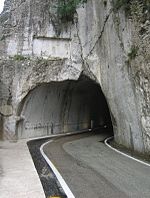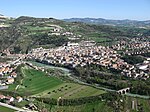Candigliano
Italy river stubsMarche geography stubsRivers of ItalyRivers of the Province of PerugiaRivers of the Province of Pesaro and Urbino ... and 2 more
Tributaries of the MetauroUmbria geography stubs

The Candigliano is a river in the Marche and Umbria regions of Italy. Its source is in the Appennino Umbro-Marchigiano mountains in the province of Pesaro e Urbino near the border with the province of Perugia. The river flows east and forms the border between Pesaro e Urbino and Perugia for a short distance south of Mercatello sul Metauro before entering Pesaro e Urbino. It then continues flowing east past an exclave called Monte Ruperto belonging to Città di Castello and then past Piobbico, where it is joined by the Biscubio. The river is joined by the Burano at Acqualagna and flows northeast near the Furlo Pass until it joins the Metauro west of Fossombrone.
Excerpt from the Wikipedia article Candigliano (License: CC BY-SA 3.0, Authors, Images).Candigliano
Strada Statale 73 bis di Bocca Trabaria,
Geographical coordinates (GPS) Address Nearby Places Show on map
Geographical coordinates (GPS)
| Latitude | Longitude |
|---|---|
| N 43.6744 ° | E 12.7541 ° |
Address
Strada Statale 73 bis di Bocca Trabaria
Strada Statale 73 bis di Bocca Trabaria
61040
Marche, Italy
Open on Google Maps







